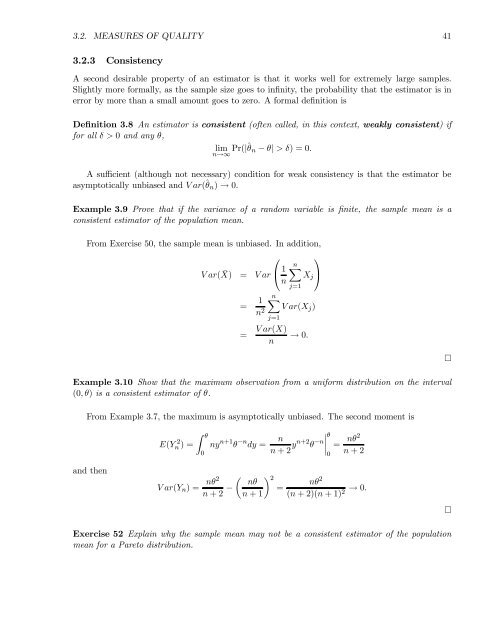Estimation, Evaluation, and Selection of Actuarial Models
Estimation, Evaluation, and Selection of Actuarial Models
Estimation, Evaluation, and Selection of Actuarial Models
You also want an ePaper? Increase the reach of your titles
YUMPU automatically turns print PDFs into web optimized ePapers that Google loves.
3.2. MEASURES OF QUALITY 41<br />
3.2.3 Consistency<br />
A second desirable property <strong>of</strong> an estimator is that it works well for extremely large samples.<br />
Slightly more formally, as the sample size goes to infinity, the probability that the estimator is in<br />
error by more than a small amount goes to zero. A formal definition is<br />
Definition 3.8 An estimator is consistent (<strong>of</strong>ten called, in this context, weakly consistent) if<br />
for all δ > 0 <strong>and</strong> any θ,<br />
lim<br />
n→∞ Pr(|ˆθ n − θ| > δ) =0.<br />
Asufficient (although not necessary) condition for weak consistency is that the estimator be<br />
asymptotically unbiased <strong>and</strong> Var(ˆθ n ) → 0.<br />
Example 3.9 Prove that if the variance <strong>of</strong> a r<strong>and</strong>om variable is finite, the sample mean is a<br />
consistent estimator <strong>of</strong> the population mean.<br />
From Exercise 50, the sample mean is unbiased. In addition,<br />
⎛<br />
Var( ¯X) = Var⎝ 1 n<br />
nX<br />
j=1<br />
X j<br />
⎞<br />
⎠<br />
= 1 nX<br />
n 2 Var(X j )<br />
j=1<br />
= Var(X)<br />
n<br />
Example 3.10 Show that the maximum observation from a uniform distribution on the interval<br />
(0, θ) is a consistent estimator <strong>of</strong> θ.<br />
→ 0.<br />
From Example 3.7, the maximum is asymptotically unbiased. The second moment is<br />
¤<br />
E(Y 2 n )=<br />
Z θ<br />
0<br />
ny n+1 θ −n dy =<br />
n<br />
n +2 yn+2 θ −n¯¯¯¯<br />
θ<br />
0<br />
= nθ2<br />
n +2<br />
<strong>and</strong> then<br />
Var(Y n )=<br />
µ nθ2 nθ 2<br />
n +2 − =<br />
n +1<br />
nθ 2<br />
(n +2)(n +1) 2 → 0. ¤<br />
Exercise 52 Explain why the sample mean may not be a consistent estimator <strong>of</strong> the population<br />
mean for a Pareto distribution.
















